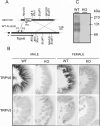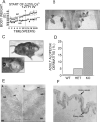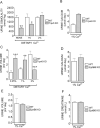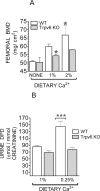Marked disturbance of calcium homeostasis in mice with targeted disruption of the Trpv6 calcium channel gene
- PMID: 17129178
- PMCID: PMC4548943
- DOI: 10.1359/jbmr.061110
Marked disturbance of calcium homeostasis in mice with targeted disruption of the Trpv6 calcium channel gene
Abstract
We report the phenotype of mice with targeted disruption of the Trpv6 (Trpv6 KO) epithelial calcium channel. The mice exhibit disordered Ca(2+) homeostasis, including defective intestinal Ca(2+) absorption, increased urinary Ca(2+) excretion, decreased BMD, deficient weight gain, and reduced fertility. Although our Trpv6 KO affects the closely adjacent EphB6 gene, the phenotype reported here is not related to EphB6 dysfunction.
Introduction: The mechanisms underlying intestinal Ca(2+) absorption are crucial for overall Ca(2+) homeostasis, because diet is the only source of all new Ca(2+) in the body. Trpv6 encodes a Ca(2+)-permeable cation channel responsible for vitamin D-dependent intestinal Ca(2+) absorption. Trpv6 is expressed in the intestine and also in the skin, placenta, kidney, and exocrine organs.
Materials and methods: To determine the in vivo function of TRPV6, we generated mice with targeted disruption of the Trpv6 (Trpv6 KO) gene.
Results: Trpv6 KO mice are viable but exhibit disordered Ca(2+) homeostasis, including a 60% decrease in intestinal Ca(2+) absorption, deficient weight gain, decreased BMD, and reduced fertility. When kept on a regular (1% Ca(2+)) diet, Trpv6 KO mice have deficient intestinal Ca(2+) absorption, despite elevated levels of serum PTH (3.8-fold) and 1,25-dihydroxyvitamin D (2.4-fold). They also have decreased urinary osmolality and increased Ca(2+) excretion. Their serum Ca(2+) is normal, but when challenged with a low (0.25%) Ca(2+) diet, Trpv6 KO mice fail to further increase serum PTH and vitamin D, ultimately developing hypocalcemia. Trpv6 KO mice have normal urinary deoxypyridinoline excretion, although exhibiting a 9.3% reduction in femoral mineral density at 2 months of age, which is not restored by treatment for 1 month with a high (2%) Ca(2+) "rescue" diet. In addition to their deranged Ca(2+) homeostasis, the skin of Trpv6 KO mice has fewer and thinner layers of stratum corneum, decreased total Ca(2+) content, and loss of the normal Ca(2+) gradient. Twenty percent of all Trpv6 KO animals develop alopecia and dermatitis.
Conclusions: Trpv6 KO mice exhibit an array of abnormalities in multiple tissues/organs. At least some of these are caused by tissue-specific mechanisms. In addition, the kidneys and bones of Trpv6 KO mice do not respond to their elevated levels of PTH and 1,25-dihydroxyvitamin D. These data indicate that the TRPV6 channel plays an important role in Ca(2+) homeostasis and in other tissues not directly involved in this process.
Figures







References
-
- Frick KK, Bushinsky DA. Molecular mechanisms of primary hypercalciuria. J Am Soc Nephrol. 2003;14:1082–1095. - PubMed
-
- Peng JB, Brown EM, Hediger MA. Structural conservation of the genes encoding cat1, cat2, and related cation channels. Genomics. 2001;76:99–109. - PubMed
-
- Vennekens R, Hoenderop JG, Prenen J, Stuiver M, Willems PH, Droogmans G, Nilius B, Bindels RJ. Permeation and gating properties of the novel epithelial Ca(2+) channel. J Biol Chem. 2000;275:3963–3969. - PubMed
-
- Song Y, Peng X, Porta A, Takanaga H, Peng JB, Hediger MA, Fleet JC, Christakos S. Calcium transporter 1 and epithelial calcium channel messenger ribonucleic acid are differentially regulated by 1,25 dihydroxyvitamin D3 in the intestine and kidney of mice. Endocrinology. 2003;144:3885–3894. - PubMed
Publication types
MeSH terms
Substances
Grants and funding
LinkOut - more resources
Full Text Sources
Molecular Biology Databases
Research Materials
Miscellaneous

